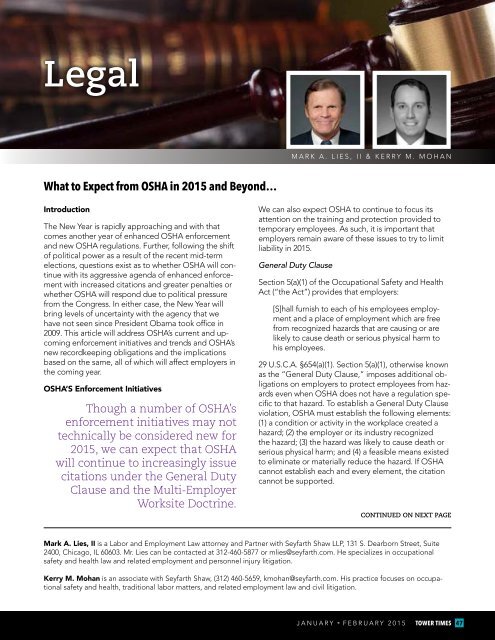Jan-Feb-2015-TT-for-Website
Jan-Feb-2015-TT-for-Website
Jan-Feb-2015-TT-for-Website
Create successful ePaper yourself
Turn your PDF publications into a flip-book with our unique Google optimized e-Paper software.
Legal<br />
MARK A. LIES, II & KERRY M. MOHAN<br />
What to Expect from OSHA in <strong>2015</strong> and Beyond…<br />
Introduction<br />
The New Year is rapidly approaching and with that<br />
comes another year of enhanced OSHA en<strong>for</strong>cement<br />
and new OSHA regulations. Further, following the shift<br />
of political power as a result of the recent mid-term<br />
elections, questions exist as to whether OSHA will continue<br />
with its aggressive agenda of enhanced en<strong>for</strong>cement<br />
with increased citations and greater penalties or<br />
whether OSHA will respond due to political pressure<br />
from the Congress. In either case, the New Year will<br />
bring levels of uncertainty with the agency that we<br />
have not seen since President Obama took office in<br />
2009. This article will address OSHA’s current and upcoming<br />
en<strong>for</strong>cement initiatives and trends and OSHA’s<br />
new recordkeeping obligations and the implications<br />
based on the same, all of which will affect employers in<br />
the coming year.<br />
OSHA’S En<strong>for</strong>cement Initiatives<br />
Though a number of OSHA’s<br />
en<strong>for</strong>cement initiatives may not<br />
technically be considered new <strong>for</strong><br />
<strong>2015</strong>, we can expect that OSHA<br />
will continue to increasingly issue<br />
citations under the General Duty<br />
Clause and the Multi-Employer<br />
Worksite Doctrine.<br />
We can also expect OSHA to continue to focus its<br />
attention on the training and protection provided to<br />
temporary employees. As such, it is important that<br />
employers remain aware of these issues to try to limit<br />
liability in <strong>2015</strong>.<br />
General Duty Clause<br />
Section 5(a)(1) of the Occupational Safety and Health<br />
Act (“the Act”) provides that employers:<br />
[S]hall furnish to each of his employees employment<br />
and a place of employment which are free<br />
from recognized hazards that are causing or are<br />
likely to cause death or serious physical harm to<br />
his employees.<br />
29 U.S.C.A. §654(a)(1). Section 5(a)(1), otherwise known<br />
as the “General Duty Clause,” imposes additional obligations<br />
on employers to protect employees from hazards<br />
even when OSHA does not have a regulation specific<br />
to that hazard. To establish a General Duty Clause<br />
violation, OSHA must establish the following elements:<br />
(1) a condition or activity in the workplace created a<br />
hazard; (2) the employer or its industry recognized<br />
the hazard; (3) the hazard was likely to cause death or<br />
serious physical harm; and (4) a feasible means existed<br />
to eliminate or materially reduce the hazard. If OSHA<br />
cannot establish each and every element, the citation<br />
cannot be supported.<br />
CONTINUED ON NEXT PAGE<br />
Mark A. Lies, II is a Labor and Employment Law attorney and Partner with Seyfarth Shaw LLP, 131 S. Dearborn Street, Suite<br />
2400, Chicago, IL 60603. Mr. Lies can be contacted at 312-460-5877 or mlies@seyfarth.com. He specializes in occupational<br />
safety and health law and related employment and personnel injury litigation.<br />
Kerry M. Mohan is an associate with Seyfarth Shaw, (312) 460-5659, kmohan@seyfarth.com. His practice focuses on occupational<br />
safety and health, traditional labor matters, and related employment law and civil litigation.<br />
■<br />
JANUARY FEBRUARY <strong>2015</strong> TOWER TIMES 47







